Call it what you will - snowsports touring, backcountry skiing/boarding, ski mountaineering - more and more people are chosing to slide over rather than plod through the snow in Scotland's mountains, and are enjoying the freedom of doing it away from the confines of pisted ski areas. The challenge and rewards of ski mountaineering are immense for those
willing to invest in the kit and physical effort required to explore
some of the most dramatic and remote parts of the UK.
Snow sports touring is said by its fans to be the most complete and satisfying way to travel in the mountains, but you do need to earn your turns. You need the hill fitness to help you glide your skis or split boards to the more remote summits - and you need all the skill of the winter mountaineer. The Scottish mountains in winter can be wild and you need to be able to navigate, avoid avalanche, and survive.
The trick is to go with a competent team who can introduce you progressively and within your capabilities. For those who are not mountaineers, you should go with those who are: friends, courses or clubs who can help make your first experience one that’ll have you hooked for life.
Some people are self-taught, but there are negatives with this approach.
The first is just how quickly it is possible to get into a very serious situation, particularly sliding downhill on snow. Fun turns and a little speed are so addictive that you can easily find yourself misplaced in the mist.
The second issue is one of learning in isolation. It is very special to feel part of a select group of folk doing their thing in the mountains, but learning from books and DVDs can be a long slow process.
Joining clubs or organised courses makes much more sense. Glenmore Lodge, the Scottish National Outdoor Training Centre, offers a range of ski mountaineering courses, from introductory level through to advanced and abroad.
If you are concerned about your ski ability and how well you will adapt to the off-piste, then you might consider a few lessons. Most ski schools will have instructors who love to ski off piste.
You will also get good advice on equipment from your local retailers.
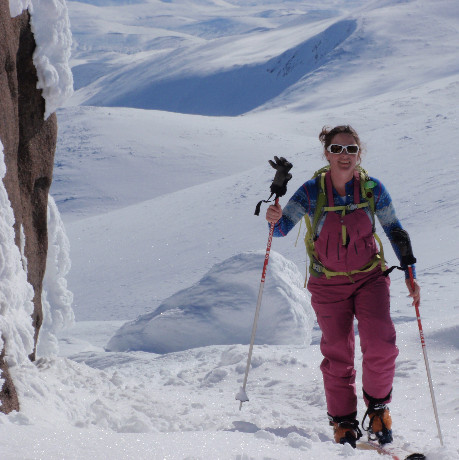
Skiing on Beinn Mheadhoinn. Photo by Heather Morning
Many snowsports tourers set off on their adventures from managed ski areas.
The snowsports touring access code has been developed with our partners and the endorsement of resort managers and users to raise awareness of tourers’ access rights and responsibilities and help everyone enjoy their day out on the hill.
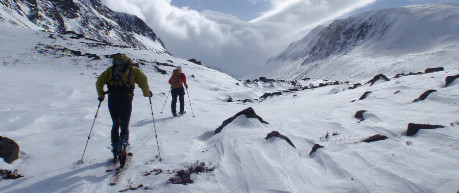
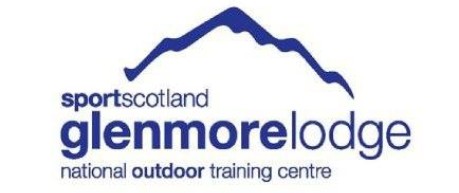
There is a strong tradition of skiing at Glenmore Lodge, which offers a range of courses in ski-touring and off piste skiing, from introductory to advanced level.
In these videos Glenmore Lodge instructor Andy Townsend runs through some of the key considerations when buying skis and bindings for ski touring.
Snow sports touring is potentially a high risk sport so always ThinkWINTER!
Before setting off on any trip, you should assess the risk and make educated decisions on your route choice based on that assessment. Travel in the back country of Scotland requires a combination of mountaineering and snow sport skills to ensure safe travel and an enjoyable, rewarding trip.
It is essential you consider the following before and during your trip:
Awareness of the avalanche risk and its effect on your route choice is even more of a priority than when you travel on foot in winter. By the nature of the activity, ski mountaineers/boarders will be looking to head for areas that have good snow cover, unlike mountaineers who may choose a line that is scoured of snow. A key resource is the SAIS forecast service. If you feel you need more advice on avalanche awareness you can sign up for one of our avalanche courses.
The recent weather will affect the snow conditions as well as the day(s) you're out, so keep an eye on it in the days before you go as well as checking in with the forecast the night before and changing your plans if necessary.
You can access a range of mountain weather forecasts here and current snow conditions can be viewed at www.winterhighland.info
Find out more about essential navigation skills for safe travel in the back country of Scotland here.
Travel on ski/board presents its own unique navigational challenges, particularly when travelling in descent in white-out conditions where judgement of distance by timing and pacing can be very challenging. It is strongly recommended that traditional map and compass skills are backed up with a GPS and/or altimeter to aid navigation. Particular care should be taken in the vicinity of summits/cornice corrie rims. If you require more advice on navigation skills in relation to snowsport touring, you can sign up for one of our snow sports touring courses.
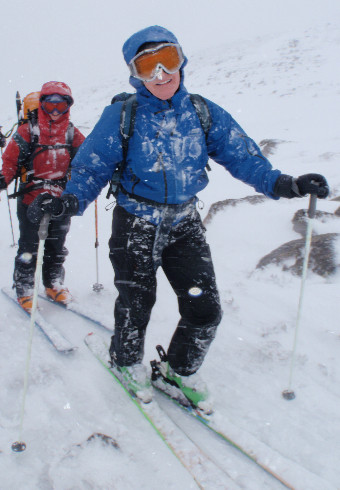
Photo by Heather Morning
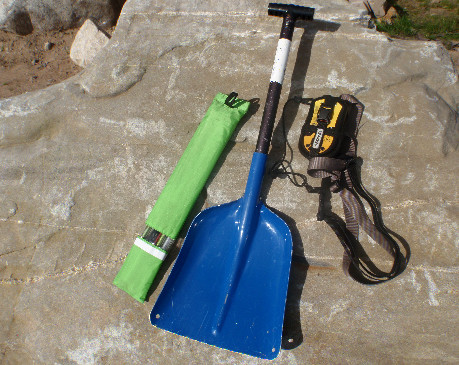
Transceiver, shovel and probes - recommended for back country skiing
It is strongly recommend that ski/boarders travelling in the back country of Scotland each carry a shovel, probe, transceiver, ice axe, crampons and/or ski crampons – and, of course, know how and when to use them. You may also choose to wear a helmet, depending on the steepness of terrain you intend to travel on. See here for more information about helmets.
Each person should also carry essential items in the event of emergency. These include mobile phone, synthetic duvet jacket, bivi bag and group shelter.
It is vital that you plan your adventures according to your level of competence. You and your party should build up your expertise in both navigation and technical ski/board skills in a progressive manner. Remember the ski/board lines will always return, the trick is making sure that you are around to enjoy them.
The best way to learn is on the hill, with either a more knowledgeable friebnd or a professional instructor, but this series of videos from Glenmore Lodge gives a taste of some of the skills which will be useful in ski mountaineering.
3. Kick turns
5. Downhill skiing with skins on, snow plough style
6. Downhill skiing with skins on
8. Stem turns
9. Navigating in poor visibility
10. Jump turns